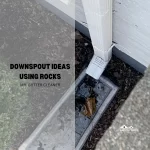Unclogging a gutter downspout is a critical home maintenance task that ensures water flows freely away from a home’s foundation, preventing potential water damage.
Clogged downspouts, often filled with leaves, debris, and sometimes pest nests, hinder this flow, leading to overflow and potential structural issues.
Homeowners seek reliable information to tackle this problem effectively, underscoring the importance of understanding the causes, signs, and solutions for clogged downspouts.
This guide equips homeowners with the necessary steps to identify and address blockages, from the initial inspection to preventive measures for future clogs.
With a focus on practical, actionable advice, it aims to simplify the process, emphasizing the use of common tools and safety precautions.
Additionally, it provides insights into when professional help may be needed, ensuring homeowners can maintain their gutters efficiently and effectively.
This approach not only supports home upkeep but also empowers homeowners with knowledge to protect their investment.
What Causes Downspout Clogs?
Downspout clogs stem from various sources, but the most common are leaves, debris, and pest nests. These materials accumulate in gutters over time and eventually block the flow of water through downspouts. Leaves, a natural part of the environment, fall and gather in gutters, especially during autumn. When mixed with rainwater, they form a sludge that can harden and obstruct downspouts. Debris, including twigs, dirt, and artificial materials blown by the wind, also contributes to clogs. Additionally, pests such as birds and insects may build nests in the sheltered spaces of gutters and downspouts, further blocking water flow. This obstruction can lead to water overflow, damaging the home’s exterior and foundation. Regular inspection and cleaning of gutters and downspouts are essential preventive measures to avoid these issues and maintain the home’s integrity.
Table of Contents:
- What Causes Downspout Clogs?
- Signs Your Gutter Downspout Is Clogged
- Preparing to Unclog Your Downspout
- Step-by-Step Guide to Unclogging a Downspout
- Preventing Future Downspout Clogs
- Troubleshooting Common Downspout Problems
- When to Call a Professional for Gutter Services
- FAQs About Gutter Downspout Maintenance
How Do Leaves and Debris Lead to Clogs?
Leaves and debris are the primary causes of downspout clogs. As trees shed their foliage, leaves accumulate in gutters and travel to downspouts, where they gather and compact. This accumulation, along with small twigs, dirt, and other organic materials carried by wind, obstructs water flow. This blockage can lead to overflow and potential damage to the home’s foundation and landscaping.
Can Pest Nests Block Downspouts?
Pest nests significantly obstruct downspouts. Birds, squirrels, and insects often choose gutters for nesting due to their secluded and elevated location. These nests not only impede water flow but can also attract more pests, exacerbating the blockage and potentially damaging the gutter system. The presence of nests necessitates additional steps or professional help to clear the gutter system and maintain its functionality.
Signs Your Gutter Downspout Is Clogged
Clogged gutter downspouts disrupt water flow from your roof, potentially leading to water damage. Recognizing the signs early can save homeowners from costly repairs.
Water Spills Over Gutter Edges
When downspouts are clogged, water cannot flow through them and instead spills over the gutter edges. This overflow is often the most visible sign of a blockage, particularly noticeable during heavy rain. Consistent overflow can damage landscaping, erode foundations, and lead to basement flooding.
Visible Debris at the Downspout Opening
A clear indication of a clogged downspout is the presence of visible debris at its opening. Leaves, twigs, and sediment accumulation can be seen sticking out from the downspout entrance or lodged within it, suggesting a blockage that impedes water flow.
Unusual Noises During Rainfall
Gurgling or splashing sounds emanating from the gutters during rain are telltale signs of obstruction within the downspout. These sounds occur as water struggles to navigate through the clog, indicating that an inspection and potential cleaning are necessary.
Preparing to Unclog Your Downspout
Unclogging a gutter downspout requires proper preparation, both in terms of gathering the necessary tools and ensuring safety measures are in place. This preparation is crucial for efficient and safe cleaning.
What Tools Do You Need?
To unclog a downspout effectively, homeowners need a few essential tools. These include a ladder that reaches your gutters comfortably, gloves to protect your hands, a garden hose with a nozzle for flushing, a plumber’s snake for dislodging clogs, and a bucket or trash bags for debris. Optionally, a power washer can be used for tough clogs, provided it’s handled with care to avoid damage to the gutters.
Safety Measures to Consider
Safety is paramount when working at heights. Ensure the ladder is stable and securely placed on even ground. Using a ladder stabilizer can prevent it from damaging the gutters and provide additional safety. Wear non-slip shoes and use gloves to protect against sharp objects. Never lean over the ladder’s sides and always have someone nearby in case assistance is needed. Understanding these safety protocols and having the right tools at hand are the first steps toward effectively addressing downspout clogs, setting the stage for a successful unclogging process.
Step-by-Step Guide to Unclogging a Downspout
Unclogging a gutter downspout is a straightforward process that homeowners can undertake with the right tools and techniques. This guide provides a methodical approach to efficiently clear blockages and restore proper water flow.
Initial Inspection and Cleaning
Begin with a visual inspection to locate the clog. Remove visible debris from the gutter and downspout entrance using gloves. This initial cleaning can often resolve minor blockages and prevent water from overflowing.
How to Use a Plumber’s Snake
For deeper clogs, a plumber’s snake is an effective tool. Insert the snake into the downspout from the top, pushing it downward until you feel resistance. Rotate the snake to break apart the clog, then slowly withdraw it. This may need to be repeated several times to clear all debris.
Flushing the Downspout with Water
After breaking up the clog, flush the downspout with water using a garden hose. The pressure from the hose will help remove any remaining debris. If water flows freely out the bottom, the clog has been successfully removed.
When to Use a Power Washer
A power washer should be used cautiously as it can damage the gutters or downspout if not handled properly. It’s most effective for stubborn clogs that a plumber’s snake can’t clear. Insert the washer hose from the top of the downspout, using low pressure initially, then gradually increasing as needed to dislodge the clog.
Preventing Future Downspout Clogs
Preventing downspout clogs is key to maintaining a functional gutter system, protecting your home from water damage, and avoiding the need for frequent cleanings. Implementing proactive measures can significantly reduce the risk of clogs.
Installing Gutter Guards: Pros and Cons
Gutter guards can effectively prevent leaves and debris from entering the gutters, significantly reducing the likelihood of clogs. The benefits include less frequent cleanings and prolonged gutter life. However, they are not foolproof and require an initial investment. Some types of guards may still allow smaller debris to accumulate and can be difficult to install, necessitating professional help.
Regular Gutter Maintenance Schedule
Establishing a regular cleaning schedule is crucial for preventing clogs. Cleaning gutters at least twice a year, typically in the spring and fall, can prevent the accumulation of debris that leads to clogs. This schedule may need adjustment based on the number of trees near your home and local weather conditions.
The Importance of Professional Gutter Inspections
Professional inspections can identify potential problems before they lead to clogs. Experts can spot issues like minor damages, improperly aligned gutters, or areas prone to accumulating debris. Regular inspections, ideally once a year, can save homeowners significant repair costs by preventing water damage early.
Troubleshooting Common Downspout Problems
Even with regular maintenance, downspouts can experience issues that impede their functionality. Troubleshooting these problems promptly can prevent further damage and ensure your gutter system works efficiently.
What to Do If Water Still Doesn’t Drain
If water doesn’t drain after unclogging efforts, further investigation is needed. First, ensure the downspout isn’t clogged at a lower point than initially inspected. If the blockage is not visible, a plumber’s snake or a hose might be required to dislodge deeper clogs. Persistent issues might indicate a need for disassembly or professional assessment.
Addressing Downspout Detachment or Damage
Detached or damaged downspouts fail to direct water away from the home effectively, risking foundation and landscape damage. For detachment, securely reattach the downspout to the gutter and siding using appropriate fasteners and brackets. If the downspout is damaged, assess whether a repair can restore its functionality or if replacement is necessary. Minor holes or cracks can often be sealed, but extensive damage typically warrants a new downspout.
When to Call a Professional for Gutter Services
There are instances when DIY efforts may not suffice, and the expertise of a professional gutter service becomes essential. Recognizing when to call in the professionals can save homeowners time, ensure safety, and prevent potential damage.
Recognizing the Limits of DIY Gutter Maintenance
While many gutter issues can be addressed through DIY methods, certain conditions warrant professional intervention. This includes situations where downspouts are severely clogged deep within, inaccessible without special tools, or when the gutter system is damaged or requires parts replacement. If after attempting to unclog a downspout the problem persists, or if you are unable to safely reach the gutters, it is time to seek professional help.
How to Choose a Reliable Gutter Service Provider
Selecting a dependable gutter service provider is crucial. Look for companies with good reputations, verified reviews, and appropriate licensing and insurance. Ask for detailed quotes, understand the services offered, and inquire about guarantees on the work performed. A reputable provider will conduct a thorough assessment, offer clear communication about the necessary work, and provide a reliable timeline for completion.
FAQs About Gutter Downspout Maintenance
Frequently asked questions (FAQs) about gutter downspout maintenance provide homeowners with quick, actionable insights to ensure their gutter systems function efficiently. Addressing these questions can help maintain the health of your home’s exterior and prevent water damage.
How Often Should I Clean My Gutters?
Gutters should be cleaned at least twice a year, typically in the spring and fall, to prevent clogs and ensure proper water flow. Homes surrounded by trees may require more frequent cleaning, as falling leaves can quickly lead to blockages.
Can I Unclog a Downspout in Winter?
Unclogging a downspout in winter is possible but may require extra precautions due to cold weather and potential ice formation. If water is not draining and ice is suspected, applying warm water can help melt the blockage. However, for safety and to prevent damage to the gutters, consider consulting a professional.
Are Gutter Guards Worth the Investment?
Gutter guards can significantly reduce the amount of debris that enters your gutters, decreasing the frequency of clogs and cleanings. While they represent an initial investment, they can save money and time in the long run. However, it’s important to choose the right type of gutter guard for your environment and to understand that no guard eliminates the need for occasional gutter maintenance.


